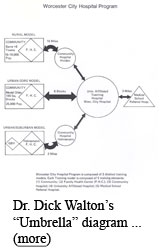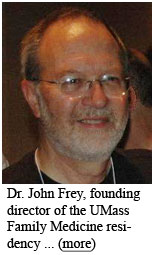Family Medicine Comes to Massachusetts (cont'd.)
From 1973, Walton's planning for a Family Medicine program—including accredited residency sites throughout Central Massachusetts—began in earnest. In response to the request of both the Dean of the medical school and the UMass Trustees, he set about creating a five-year plan for the program. After consulting the writings of G. Gayle Stephens and visiting an existing rural residency site in the Blackstone Valley of Virginia, he produced a plan that has been known ever since as the "Umbrella":
Department Chair Dan Lasser remembers that when he first began at UMass as residency director, Dick Walton …
had these diagrams. I got here in '79 and one of the first things that people did was they said, you've got to look at Dick Walton's diagrams and memorize them and imprint them in your brain. One diagram was a triangle - university, community and health center. The second diagram was an umbrella, and I have these here somewhere, actually. The umbrella was a whole series of different training tracks to meet the public need. And so there was going to be an inner city track, that was going to be based at a community health center, and at that time, Family Health and [Social] Service was just evolving as a model out of the model cities program, and so they were going to establish a track there. Equal partnership, full collaboration. They were going to develop a rural track, the Barre Health Center. They were going to develop, I think they called it a private practice track, and that was Bob Babineau's private practice in Fitchburg - they were going to turn that into a residency program.(38)
The residents, Walton decided, should have a choice of three different outpatient sites: one rural, one urban-suburban, and one
inner-city location. Each health center would have admitting privileges at the hospital to which its patients lived closest, with
the residency's central site at Worcester City Hospital. (University Hospital did not fully open until 1976.) Holding the three
 umbrella "spokes" together would be the Family Medicine Department itself, eventually with offices at the medical school, but
initially based at City Hospital. And so, Walton persuaded three sites to affiliate with the new residency, while a fourth site, an
independently credentialed residency program at Fitchburg, became formally affiliated five years later. The sites included the Barre
Family Health Center (rural; 1973), the community-run, federally-funded Family Health and Socal Service Center of Worcester (now,
the Family Health Center-Worcester) in downtown Worcester (urban; 1974), and, the Hahnemann Family Health Center (urban-suburban;
1975). In 1979, the Fitchburg Family Practice Center (now, Community Health Connections Family Health Center) became the fourth site
to affiliate with the program, representing the model of a predominantly blue collar small city.(39)
umbrella "spokes" together would be the Family Medicine Department itself, eventually with offices at the medical school, but
initially based at City Hospital. And so, Walton persuaded three sites to affiliate with the new residency, while a fourth site, an
independently credentialed residency program at Fitchburg, became formally affiliated five years later. The sites included the Barre
Family Health Center (rural; 1973), the community-run, federally-funded Family Health and Socal Service Center of Worcester (now,
the Family Health Center-Worcester) in downtown Worcester (urban; 1974), and, the Hahnemann Family Health Center (urban-suburban;
1975). In 1979, the Fitchburg Family Practice Center (now, Community Health Connections Family Health Center) became the fourth site
to affiliate with the program, representing the model of a predominantly blue collar small city.(39)
And there were lots of big arguments at the national level about [the substance of family medicine residencies]. The westerners, particularly, the west coast, in the 60s, the west coast GPs did lots more overall, than the east coast general practitioners. For example, west coast GPs, with no specific training, did surgery - did cesarean sections, major surgery. That was on the decline on the east coast. So there were lots of discussions about the training program itself… and somehow at that time, of course, when the medical school was being established, again, it was a discussion of what's it going to train? And the mandate, as you recall, from the legislature was to train primary care physicians, and at that time, that's when I met Dick. And at that time, the medical school was having a big discussion about what should primary care physicians be? Should they be trained only in medicine? And the internists felt that was the way to go, but the pediatricians felt, no. We family doctors thought it should be a broader training.--Robert A. Babineau, M.D.
Luckily for Walton, in 1974 a freshly minted graduate of one of the earliest Family Medicine
 residencies—Dr. Lynn Carmichael's program at the University of Miami—Dr. John Frey, heard about the new program, came
looking for a job, and was hired as the new Residency Director.(40) Walton and Frey both remember his job
interview—Walton took him to the Struck of Loke Café (the
Struck Café became one of Worcester's best restaurants, but was then a more modest establishment) and spent the evening portraying
the excitement and sense of possibility inherent in starting a new program, in a new medical school, in a new
discipline. As the evening
wound down to its conclusion, Walton discovered he had left his wallet at home: John Frey paid for their dinners. And, he took
the job as director of the residency program and medical director at the Family Health and Social Service Center in Worcester. Dick
Walton is a persuasive fellow.
residencies—Dr. Lynn Carmichael's program at the University of Miami—Dr. John Frey, heard about the new program, came
looking for a job, and was hired as the new Residency Director.(40) Walton and Frey both remember his job
interview—Walton took him to the Struck of Loke Café (the
Struck Café became one of Worcester's best restaurants, but was then a more modest establishment) and spent the evening portraying
the excitement and sense of possibility inherent in starting a new program, in a new medical school, in a new
discipline. As the evening
wound down to its conclusion, Walton discovered he had left his wallet at home: John Frey paid for their dinners. And, he took
the job as director of the residency program and medical director at the Family Health and Social Service Center in Worcester. Dick
Walton is a persuasive fellow.
In a 1975 list of objectives for the new residency program, prepared as part of his five-year plan, Walton enumerated the following eight goals:
- To develop a statewide network of residency programs … under a University umbrella.
- To help define and develop a system of health care delivery and the functions of the family physicians under that system.
- To develop an early and organized continuum of educational exposure to the discipline of Family Medicine for the undergraduate.
- To increase the supply of well-trained family physicians in Massachusetts and New England.
- To encourage a closer link between the University and the practicing physicians; including … teaching; [continuing medical education]; and facilitated linkages for patient consultation and referral.
- To establish in collaboration with the practicing family physicians a strong research base in the training programs in the areas of clinical, operational, educational and basic research.
- To [better define] the discipline of Family Medicine, and [integrate] those portions of the other specialties and basic sciences that seem most applicable.
- To develop the basic science and clinical skills of community medicine in … undergraduate, graduate and continuing education … to make the family physician a more effective community physician.(41)
